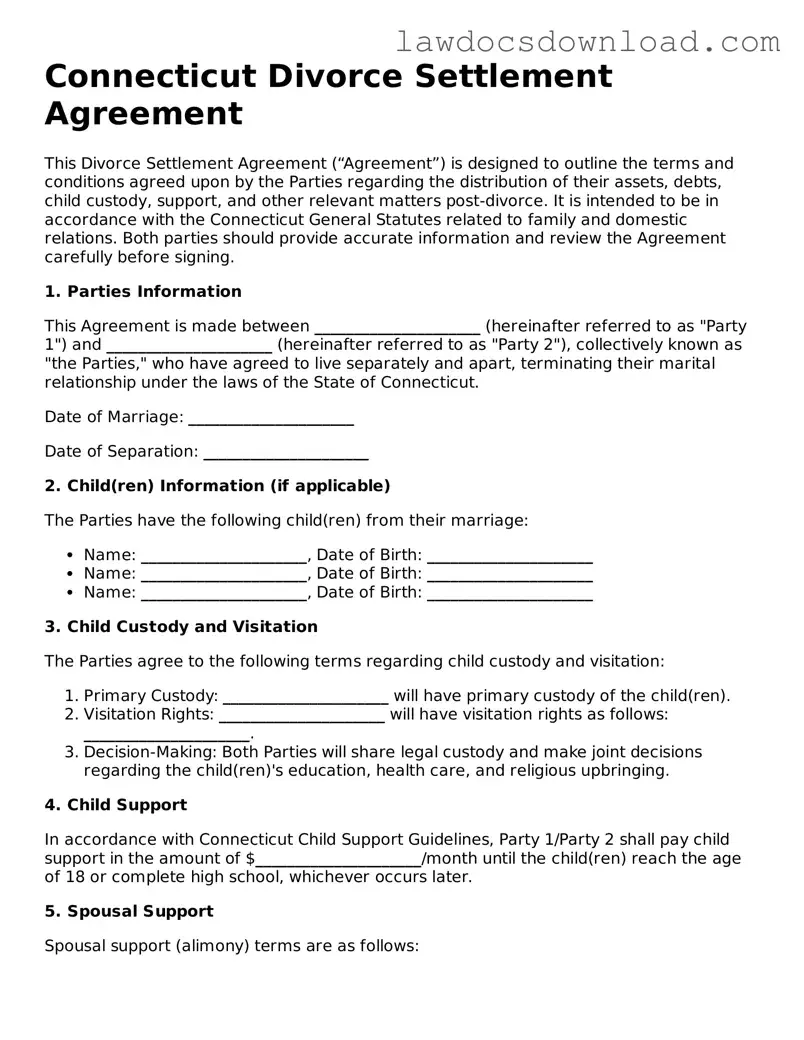Connecticut Divorce Settlement Agreement
This Divorce Settlement Agreement (“Agreement”) is designed to outline the terms and conditions agreed upon by the Parties regarding the distribution of their assets, debts, child custody, support, and other relevant matters post-divorce. It is intended to be in accordance with the Connecticut General Statutes related to family and domestic relations. Both parties should provide accurate information and review the Agreement carefully before signing.
1. Parties Information
This Agreement is made between _____________________ (hereinafter referred to as "Party 1") and _____________________ (hereinafter referred to as "Party 2"), collectively known as "the Parties," who have agreed to live separately and apart, terminating their marital relationship under the laws of the State of Connecticut.
Date of Marriage: _____________________
Date of Separation: _____________________
2. Child(ren) Information (if applicable)
The Parties have the following child(ren) from their marriage:
- Name: _____________________, Date of Birth: _____________________
- Name: _____________________, Date of Birth: _____________________
- Name: _____________________, Date of Birth: _____________________
3. Child Custody and Visitation
The Parties agree to the following terms regarding child custody and visitation:
- Primary Custody: _____________________ will have primary custody of the child(ren).
- Visitation Rights: _____________________ will have visitation rights as follows: _____________________.
- Decision-Making: Both Parties will share legal custody and make joint decisions regarding the child(ren)'s education, health care, and religious upbringing.
4. Child Support
In accordance with Connecticut Child Support Guidelines, Party 1/Party 2 shall pay child support in the amount of $_____________________/month until the child(ren) reach the age of 18 or complete high school, whichever occurs later.
5. Spousal Support
Spousal support (alimony) terms are as follows:
- Party 1/Party 2 will pay alimony in the amount of $_____________________/month for a period of _____________________ years/months.
- Other terms: _____________________
6. Property and Debt Division
All marital property shall be divided between the Parties as follows:
Real Property located at _____________________ shall be _____________________.
Personal Property, including but not limited to household furnishings, vehicles, and bank accounts, shall be divided as follows: _____________________.
The Parties agree that debts shall be allocated as follows: _____________________.
7. Complete Agreement
This Agreement constitutes the entire agreement between the Parties concerning their divorce settlement and supersedes all prior discussions, agreements, and understandings of every kind and nature between them.
8. Governing Law
This Agreement shall be governed, interpreted, and enforced in accordance with the laws of the State of Connecticut.
9. Signature of Parties
This Agreement has been entered into voluntarily, without any duress or undue influence, and is intended to be a final disposition of the matters addressed herein.
Party 1 Signature: _____________________ Date: _____________________
Party 2 Signature: _____________________ Date: _____________________
